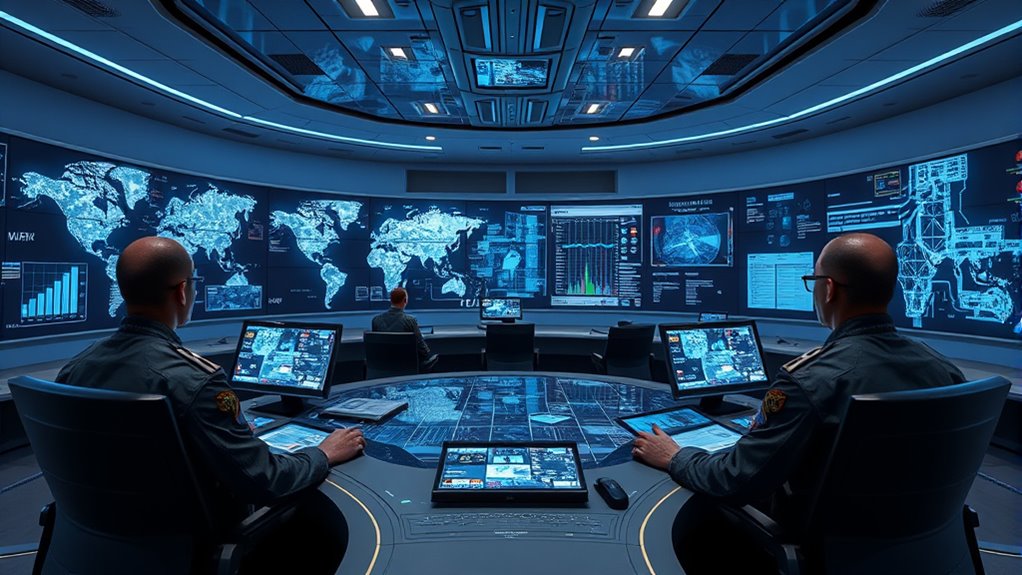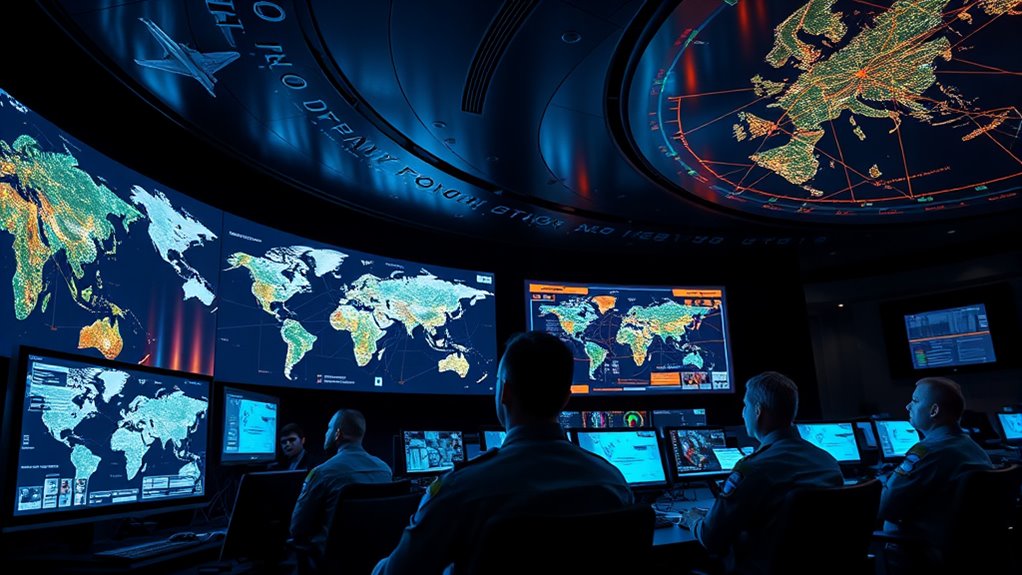Decentralized command and control systems let you make quick decisions across multiple domains like air, land, sea, cyber, and space. They empower units to act autonomously, improving agility and responsiveness even if communication links weaken. By fostering real-time information sharing and trusted decision-making, these systems enhance resilience and operational flexibility. If you explore further, you’ll discover how these innovative approaches reshape multi-domain operations for greater effectiveness and robustness.
Key Takeaways
- Enables rapid decision-making and autonomous coordination across air, land, sea, cyber, and space domains.
- Enhances operational resilience by maintaining effectiveness despite communication disruptions.
- Reduces decision delays, improving response times in complex multi-domain scenarios.
- Leverages secure, real-time information sharing to support adaptive, decentralized actions.
- Promotes system robustness and flexibility through distributed command structures and shared situational awareness.

Decentralized command and control systems enable individual units to make decisions quickly and adapt to changing situations without waiting for centralized approval. This approach hinges on distributed decision making, where each unit assesses its environment and acts accordingly. Instead of relying on a single command center, you’re empowered to respond swiftly, leveraging real-time information. This setup fosters autonomous coordination, allowing units to synchronize their actions seamlessly, even amid chaos or communication disruptions.
In a multi-domain operational context, decentralized systems are essential. You’re dealing with complex environments—air, land, sea, cyber, and space—where delays can be costly. By decentralizing control, you reduce bottlenecks, guaranteeing that decisions are made at the appropriate level, close to the action. This not only accelerates response times but also enhances flexibility. If a unit detects a threat or an opportunity, it can act immediately based on its understanding, without waiting for instructions from higher authorities. This autonomy is indispensable in dynamic scenarios where timing can determine success or failure.
Distributed decision making also improves resilience. If communication links falter or are compromised, your units can continue functioning effectively. Each unit’s ability to operate independently means the overall system remains robust, maintaining operational continuity. Autonomous coordination further supports this resilience. Units share information and coordinate their actions based on shared situational awareness, but they’re not entirely dependent on a central command for every decision. Instead, they work as a cohesive network, adapting to new information and emerging threats in real time.
This decentralized model shifts the traditional command hierarchy. You’re no longer waiting for commands; instead, you’re part of a fluid, adaptive network. This requires training and trust—units must be capable of making sound decisions and coordinating without constant oversight. Technology plays a crucial role here, providing secure communication channels and shared data platforms that facilitate autonomous coordination. These tools ensure that even as individual units act independently, their actions align with the broader mission objectives.
Furthermore, incorporating real-time information into decision-making processes is vital for maintaining agility and accuracy in multi-domain operations. Ultimately, decentralized command and control systems enhance your operational agility. They allow for rapid decision-making, foster autonomous coordination, and guarantee resilience across multiple domains. By decentralizing control, you’re better equipped to handle the complexities and uncertainties of modern multi-domain operations, maintaining a tactical advantage through speed, flexibility, and robustness.
Frequently Asked Questions
How Do Decentralized Systems Adapt to Rapid Technological Changes?
You adapt decentralized systems to rapid technological changes through enhanced adaptive agility, allowing quick responses and adjustments. By fostering technological resilience, you guarantee the system can withstand disruptions and evolving threats. This combination enables you to stay flexible and maintain operational effectiveness, even as new tools and innovations emerge. Your focus on continuous learning and modular design helps you seamlessly incorporate advancements, keeping your operations resilient and responsive to fast-paced technological shifts.
What Are the Cybersecurity Risks Associated With Decentralized Command Systems?
Like Pandora’s box, decentralized command systems harbor cyber vulnerabilities that can be exploited by malicious actors. You face risks of cyber vulnerability, where attacks bypass defenses, and insider threats, where trusted individuals act maliciously or negligently. These risks threaten data integrity and operational continuity. To safeguard your systems, implement robust security protocols, continuous monitoring, and strict access controls, ensuring that the chaos within doesn’t release a flood of cyber crises.
How Do Decentralized Systems Ensure Data Integrity Across Domains?
You guarantee data integrity across domains by implementing robust data synchronization protocols that keep information consistent and up-to-date. Trust is established through secure authentication methods and encrypted communication channels, preventing unauthorized access and tampering. Regular audits and validation checks help verify data accuracy. These measures work together to maintain the reliability of shared data, fostering confidence among all domain participants and supporting effective, coordinated decision-making in decentralized systems.
What Training Is Required for Effective Decentralized Command Operations?
You need thorough training protocols that focus on enhancing decision-making skills for effective decentralized command operations. While some might think experience alone suffices, structured training ensures clarity in roles and rapid, confident choices across domains. You should engage in scenario-based exercises, communication drills, and leadership development to build trust, adaptability, and coordination. This preparation enables you to make informed decisions swiftly, maintaining operational integrity even under complex, multi-domain challenges.
How Do Decentralized Systems Coordinate With Centralized Command Structures?
You coordinate decentralized systems with centralized command by establishing clear protocols that address interoperability challenges, ensuring smooth data sharing and communication. You empower units with decision-making autonomy, but maintain oversight to prevent conflicts. Regular training and real-time information exchange help synchronize efforts. By balancing autonomy with oversight, you enhance operational flexibility while minimizing misunderstandings, ensuring all components work together effectively despite the complexities of multi-domain operations.
Conclusion
You now see how decentralized command systems enhance flexibility and resilience in multi-domain operations. Did you know that over 70% of successful modern military missions rely on decentralized decision-making? This approach empowers units to adapt quickly, respond effectively, and maintain operational superiority. Embracing these systems means you’re at the forefront of innovative military strategy, ensuring your team stays agile and ready for any challenge across land, sea, air, and cyber domains.









